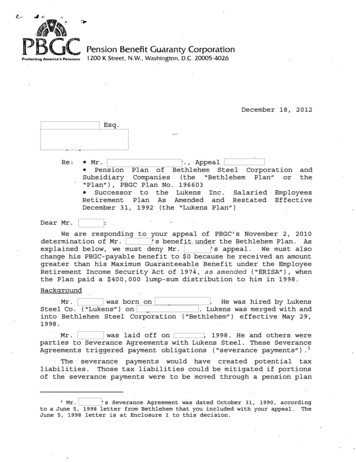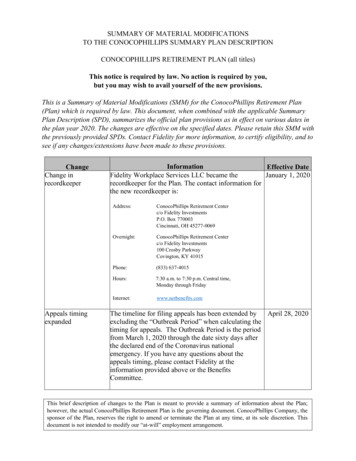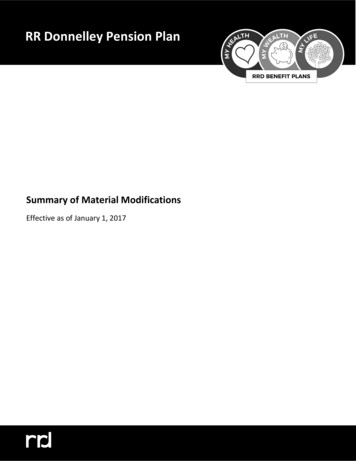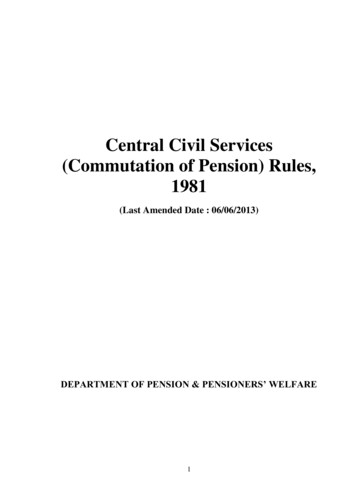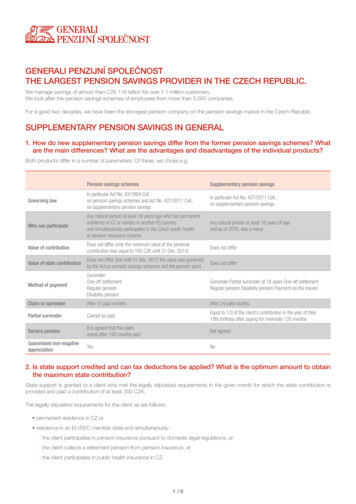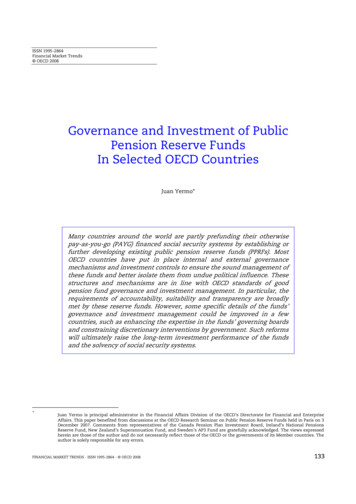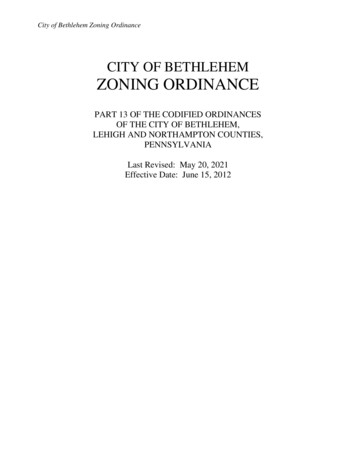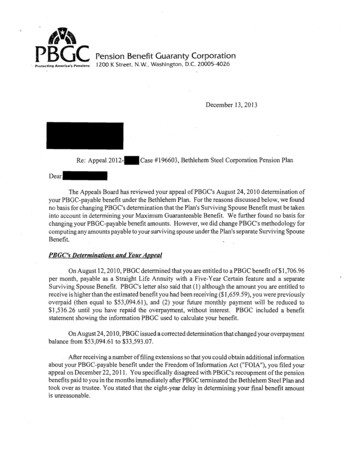
Transcription
,v PBGCProtecting America's PensionsPension Benefit Guaranty Corporation1200 K Street, N.W., Washington, D.C. Z0005-40Z6December 13,2013Re: Appeal2012--Case #196603, Bethlehem Steel Corporation Pension PlanDearThe Appeals Board ha.S reviewed your appeal of PBGC's August 24, 201 0 determination ofyour PBGC-payable benefit under the Bethlehem Plan. For the reasons discussed below, we foundno basis for changing PBGC's determination that the Plan's Surviving Spouse Benefit must be takeninto account in determining your Maximum Guaranteeable Benefit. We further found no basis forchanging your PBGC-payable benefit amounts. However, we did change PBGC's methodology forcomputing any amounts payable to your surviving spouse under the Plan's separate Surviving SpouseBenefit.PBGC's Determinations and Your AppealOn August 12,2010, PBGC determined that you are entitled to a PBGC benefit of 1,706.96per month, payable as a Straight Life Annuity with a Five-Year Certain feature and a separateSurviving Spouse Benefit. PBGC's letter also said that (1) although the amount you are entitled toreceive is higher than the estimated benefit you had been receiving ( 1 ,659.59), you were previouslyoverpaid (then equal to 53,094.61 ), and (2) your future monthly payment will be reduced to 1,536.26 until you have repaid the overpayment, without interest. PBGC included a benefitstatement showing the information PBGC used to calculate your benefit.On August 24, 201 0, PBGC issued a corrected determination that changed your overpaymentbalance from 53,094.61 to 33,593.07.After receiving a number offiling extensions so that you could obtain additional informationabout your PBGC-payable benefit under the Freedom ofinformation Act ("FOIA"), you filed yourappeal on December 22, 20 11. You specifically disagreed with PBGC's recoupment ofthe pensionbenefits paid to you in the months immediately after PBGC terminated the Bethlehem Steel Plan andtook over as trustee. You stated that the eight-year delay in determining your final benefit amountis unreasonable.
You also disagreed with PBGC's treatment of the "free surviving spouse benefit" as a jointand survivor annuity that results in a reduction to your benefit and to the benefit payable to your wifeafter your death. You further noted that, while it is understandable that PBGC must take surviving·spouse benefits into account in determining its potential liability, calculating benefits actuallypayable to participants is a different matter. You said, in particular, that after an eight-year delay,PBGC should have used then-current ages for you and your spouse, instead of your ages as of thePlan's 2002 termination date, to adjust for the surviving spouse benefit. For these reasons, youbelieve both the recoupment and free surviving spouse benefit calculations are contrary to PBGC'sfiduciary obligations under ERISA and are arbitrary and capricious. You also cited a number ofFederal court decisions you believe support your appeal.Lastly, you discussed a prior Appeals Board decision that provided a participant in theNorthwestern Steel and Wire Company Plan the opportunity to waive that Plan's Surviving SpouseBenefit. Your appeal asked for the same opportunity.BackgroundThe Bethlehem Plan terminated, effective December 18, 2002, without sufficient assets toprovide all benefits PBGC guarantees under Title IV of ERISA. PBGC became the Plan's trusteeon April30, 2003. Because oflegallimits under ERISA and PBGC's regulations, the benefits PBGCguarantees may be less than the benefits a pension plan would otherwise pay. One of these limits,the "Maximum Guaranteeable Benefit" limit, applies to your benefit.The records PBGC's auditors obtained from the former Plan administrator show that ( 1) youwere born(2) your wife was(3) you were hired by BethlehemSteel1979, and (4) you were actively employed there when the Plan terminated onDecember 18,2002. As of that date, you had -.years ofcontinuous service and average monthlyearnings of 12,417.60. E f f e c t i v e - 2003, you retired under the 70/80 Retirementprovisions of the 1999 Steel Division component of the Bethlehem Plan (nonrepresented salariedemployees). You elected, with your wife's consent, to receive your benefit in the Plan's Straight LifeAnnuity form, which includes a Five-Year Certain feature and a separate Surviving Spouse Benefit.The records further show that you received a "Sp nt" of 27,801.72 from theBethlehem Plan i 2003, covering the period from--2003 through- 2003.Beginnin 2003, the Plan began paying you a regular Plan benefit of 3,706.69 as a StraightLife Annuity with a Five-Year Certain feature and a separate Surviving Spouse Benefit.Your Bethlehem Plan BenefitUnder the 1999 Steel Plan for nonrepresented salaried employees, your benefit is the highestofthe amounts calculated under four different formulas: the Percent Pension formula, the MinimumPension formula, the Total Retirement Benefit ("TRB ")formula and the Lifetime Minimum Pensionformula. Also, because you elected to receive your Retirement Account Balance in a lump sum, yourmonthly Plan benefit must be reduced by the 126.08 per month annuity value of your Retirement- 2
Account Balance (the "RAB offset"). The calculations below show your Plan benefit under eachformula as a Straight Life Annuity with a Five-Year Certain feature and a separate Surviving SpouseBenefit:Percent Pension Formula:(1.2% yrs. x 12,417.60) (1.5% x.yrs. x 12,417.60) 3,600.48 3,600.48 permo 126.08 [RAB offset} 3,474.40 per monthMinimum Pension Formula:( 26.50 x. .yrs.) ( 28.00 x.yrs.) 630.74 630.74 permo- 126.08 [RAB offset} 504.66 per monthTRB before :(1.575% x-yrs. x 12,417.60) 4,562.82 4,562.82 x 0.8400 [early retirement} 3,832.77 3,832.77- 126.08 [RAB offset) 3,706.69 per inonthTRB after age 62: 4,562.82 - 126.08 [RAB offset] 4,436.74 4,436.74- 559.19 [Social Security Offset]:::: 3,877.55 per monthLifetime Minimum Formula: 2,000 - 126.08 [RAB offset] I ,873.92 per monthYour Plan benefit is highest under the TRB Pension Formula both before and after age 62.Surviving Spouse Benefit C'SSB")Under the provisions of Plan section 4 that apply to nonrepresented salaried employees, aneligible surviving spouse is entitled to a separate Surviving Spouse Benefit beginning the first ofthemonth following the participant's death and continuing for the life of the spouse. If an eligiblesurviving spouse is younger than age 60 at the participant's date of death, the SSB payable until heor she reaches age 60 is equal to the greater of 50% ofthe participant's benefit, or 140.00 per month(Plan section 4.2). When an eligible spouse is or reaches age 60, Plan section 4.3(d) requires thatthe pre-age 60 monthly SSB amount "be reduced by 50% ofthe amount of the widow's or widower'sbenefit ('Widow's Benefit'] to which the surviving spouse is, or upon application would be, entitledfor such month based on the [Social Security] law in effect at the time the Surviving Spouse Benefitfirst becomes payable ."but not below 90 per month. PBGC generally refers to the post-age 60reduction described above as the "Social Security Offset."Please note that the Social Security Widow's Benefit used to determine the post-age-60 offsetto the Plan's SSB is calculated in accordance with Plan provisions and based on the participant'searnings with Bethlehem.- 3
Maximum Guaranteeable Benefit (MGB)Section 4022(b)(3) of ERISA provides that PBGC's guarantee of a participant's plan benefitcannot exceed a specified dollar amount payable in the form of a Straight Life Annuity at age 65.For a plan like the Bethlehem Plan with a termination date in 2002, the MGB is 3,579.55 per monthin the form of a Straight Life Annuity for a participant who is age 65 on the Plan's termination date.Please note that PBGC can guarantee no more than a participant's MGB. The value of the MGBpayable to a particular participant whose benefit form includes a survivor benefit and a Five-YearCertain feature is equivalent to the value of the MGB payable to that participant if his or her benefitform were a Straight Life Annuity with no survivor benefits.Because you began receiving your benefit before age 65 and your regular Plan benefit is inthe form ofa Straight Life Annuity with a Five-Year Certain feature and a separate Surviving SpouseBenefit ("SSB"), PBGC must adjust the 3,579.55 amount to take into account your age and yourbenefit form. PBGC's benefits regulation (Benefits Payable in Terminated Single-Employer Plans,29 Code ofFederal Regulations§§ 4022.22 and 4022.23) sets forth the rules for adjusting the MGB.Age Adjustment FactorThe MGB for a participant who begins receiving a benefit before age 65 must be reduced toreflect the number of whole months between (A) the later of the participant's age at the Plan'stermination dat at retirement, and (B) age 65. In your case, the later date in (A) is your·retirement date,.-2003. On that date, you were age.ears.onths and.days, with.whole months remaining until you reached age 65. Under PBGC's benefits regulation, thisreduction is equal to 7112 of l% for each of the first 60 months, 4/12 of 1% for each of the next 60months, and 2112 of 1% for each of the next 120 months. Thus, your age adjustment factor is equalto:Form Adjustment FactorAs you noted in your appeal, the Bethlehem Plan does not reduce your benefit to provide forthe Five-Year C rtain feature or the separate SSB. However, PBGC's benefits regulation requiresPBGC to account for their values in the calculation of the MGB. PBGC's Actuarial TechnicalManual establishes procedures for adjusting an SSB and accounting for the value it adds to aparticipant's Straight Life Annuity.Five-Year Certain FeatureTo adjust for the Certain feature, the MOB must be reduced by 1/24 of 1% for each of thefirst 60 months and I 112 of 1% for each month beyond 60 months for each whole month remainingin the certain period after the later of the Plan termination date or th t's retirement date.Under the Bethlehem Plan, your Five-Year Certain benefit ended. 2008, which is 60-4
whole months after y o u r - 2 0 0 3 retirement date. Your period-certain adjustment factoris:1.0 - (1/24 X 0.01 X 60) 1.0 - 0.0250 0.9750SurvivingSr ouseBenefitTo adjust the MGB for the Plan's SSB, PBOC must compute an equivalent Joint and SurvivorAnnuity. As you know, PBGC uses the Weighted Average Method ("W AM"), which calculates theratio of the SSB to the total benefit payable to the participant. To determine this ratio (which PBOCcalls the "p%"), PBGC relies on actuarial factors such as age and mortality for three periods of thespouse's lifetime. As instructed by the Actuarial Technical Manual, PBGC applies these actuarialfactors from the later of the Plan's termination date and the participant's retirement date, and adjuststhe participant's MOB accordingly.Because PBGC's benefits regulation requires that PBGC calculate your MOB as ofyour dateofretirement, the value ofthe SSB is necessarily calculated before the amount ofthe SSB that wouldactually be paid to your spouse under the Plan can be determined. This is because the SocialSecurity Offset in the SSB formula increases during your retirement because the Offset amountdepends on ( l) an early-retirement factor that is calculated as ofthe date the Widow's Benefit is firstpayable, and (2) the cost-of-living adjustments ("COLAs") the Social Security Administrationapplies each year to your Social Security benefit. As a consequence, the Sodal Security Offsetincreases each month between a participant's retirement and his or her death.An SSB is first payable on the first day of the month following a participant's death. Underthe W AM, PBOC calculates a weighted-average SSB that looks at three time intervals. The FirstInterval includes all SSB start dates before the spouse reaches age 60 (i.e., the earliest age a Widow'sBenefit is payable under the Social Security Act). The Second Interval includes all SSB start datesbetween the spouse's age 60 and the age at which an unreduced Widow's Benefit is first payable(age 66The Third Interval includes all SSB start dates after the age at whichanis first payable.PBOC uses the GAM83 Unisex Mortality table specified in Rev. Rul. 95-5, 1995-1 C.B. 80,to calculate the probability that your spouse will start receiving her SSB (in other words, theprobability that you will die) in each ofthe three intervals. Thus, "Prob 1"is the probability she startsreceiving her benefit during the First Interval; "Prob2" is the probability she starts receiving herbenefit during the Second Interval; and "Prob3" is the probability she starts receiving her benefitduring the Third Interval.Under PBGC's W AM, after calculating the above probabilities, PBGC calculates the medianSSB that would be payable to an eligible spouse ifthe spouse's SSB started during the each of thethree intervals. Thus, "Med 1" is the median benefit your wife would receive during her lifetime ifshe started receiving her benefit during the First Interval; "Med2" is the median benefit she wouldreceive during her lifetime if she started receiving her benefit during the Second Interval; and-5
"Med3" is the median benefit that she would receive during her lifetime if she started receiving her ·benefit during the Third Interval.The weighted-average SSB is the numerator of the p% ratio and is calculated as follows:Weighted-average SSB (Probl x Medl) (Prob2 x Med2) (Prob3 x Med3)As discussed above, in order to calculate the median SSB payable during each of the threeintervals, PBGC must make an assumption regarding the COLAs that the Social SecurityAdministration ("SSA") will apply to your Social Security benefit between your date of retirementand your date ofdeath. For purposes of calculating the weighted-average SSB, PBGC predicted thatall future annual COLAs would be 1.4%, which was the COLA in effect in December 2002 (themonth in which the Plan terminated).According to your appeal, PBGC should have determined your p% based on actuarial factorsthat applied at the time you received your benefit determination, which was several years after PBGCbecame the Plan's trustee. However, the p% represents the percentage that the SSB constitutes ofa participant's total benefit payable after the later of a plan's termination date and a participant'sretirement date. As a percentage ofyour total benefit, the p% must be based on actuarial factors andassumptions that applied when you began receiving benefit payments. icipant like you whose spouse is .years younger (based on "age nearest birthday"as of 2003), a Straight Life Annuity with a Five-Year Certain feature and a separate SSBis actuarially equivalent to a Joint and 24.63% Survivor Annuity. The form adjustment factor fora Joint and 24.63% Survivor Annuity with 60 months' certain is 0.9029. Note that the 0.9029 formadjustment factor includes the period certain adjustment discussed on page 4 of this decision.Using the factors shown above, your MGB is: 3,579.55 [age-65 MGB] X 0.5200 [age adjustment] x 0.9029 [fonn adjustment] 1 ,680.63 per month, as a Straight Life Annuity with a Five-Year Certain feature and SSBSSB Payable To Your SpouseAs discussed above, the Board found no basis for changing PBGC's determination that theSSB must be taken into account in determining your MGB. However, during the course ofreviewing your appeal, the Board discovered a programming error in PBGC's formula for calculatingthe weighted-average SSB for participants whose benefits are affected by the MGB. Because ofthisprogramming error, PBGC's methodology for paying the SSB would produce SSB payments (asshown on the ARIEL print-out you received under FOIA) that result in a total benefit with anactuarial value that is less than the actuarial value of the MGB in the J&24.63%SA form.Due to the programming error, when PBGC calculated your spouse's weighted-average SSB,PBGC effectively assumed that the SSA's future COLAs would be 1.4% per year until your spouse's- 6
age 66 (the beginning ofthe Third Interval) and 0% thereafter, instead of 1.4% throughout the periodbetween your date of retirement and your date of death. As a result ofthe programming error, PBGCused assumptions that resulted in a higher value for the weighted-average SSB.We note that for persons like you whose benefit is affected by the MGB, PBGC would payyou and your spouse benefits that are actuarially equivalent to your MGB regardless ofwhich COLAassumptions PBGC uses so long as it uses the same COLA assumption to calculate both yourspouse's weighted average SSB and the actual SSB that your wife will receive if you die first.Accordingly, to correct for the programming error in your case, the Appeals Board decidedthat PBGC will calculate the actual SSB your wife will receive using the same assumptions PBGCused to calculate your spouse's weighted-average SSB, namely, an annual 1.4% COLA from yourretirement date to your spouse's age 66, and 0% from your spouse's age 66 to your date of death.Therefore, your spouse will receive a higher SSB than she would receive if the programming errorwere not corrected.Your PBGC-Guaranteed BenefitTo determine the PBGC-guaranteed benefit for a participant like you whose Plan benefit isnot a level amount for life, PBGC must "Jevelize" or express the Plan's benefit amounts as a singleunchanging monthly amount that includes the value of any survivor benefits. Your levelized Planbenefit is 3,817.75 per month. The ratio of your MGB to your levelized benefit determines yourPBGC Guarantee Ratio as follows: 1,680.63 [MGB] 3,817.75 [levelized benefit] 0.440214 [Guarantee Ratio]Thus, your PBGC-guaranteed benefit as a Straight Life Annuity with a Five-Year Certain feature(sipce expired) is: 1 631.74 per month ( 3,706.69 times 0.440214) from your retirement date through2008 (age 62), and- 1,706.96 per month ( 3,877.55 times 0.440214) f r o m - 2008 forward .Your Benefit FormAs discussed above, the benefit form you and your spouse elected when you retired is aStraight Life Annuity with a Five-Year Certain feature and a separate SSB. You said you and yourspouse elected the Straight Life Annuity because it was the Plan's only higher-paying alternative tothe Plan's automatic form for married participants (which is a Qualified Joint and 50% SurvivorAnnuity with a Five-Year Certain feature and a separate SSB). Now that the Plan is terminated andthe SSB is no longer subsidized, you believe it is unfair to reduce your benefit to pay for a survivorbenefit that neither you nor your spouse want.- 7
You asked that, in the event the Appeals Board upholds your PBGC benefit determination,you be permitted to waive the SSB, with the consent ofyour spouse, and re-elect the Plan's StraightLife Annuity form without an SSB. You noted that the Board has granted such requests in the past.In particular, you cited a July 29, 2005 Appeals Board decision (the "NS&W Decision") for aparticipant in the Northwestern Steel & Wire Company Pension Plan (the "NS&W Plan"). 1The NS&W Decision addressed an appeal by a participant who retired on June 1, 2001.Subsequent to that date, PBGC promulgated a regulation that provides that "once payment of abenefit starts, the benefit form cannot be changed." 2 The "change in benefit fol:m" regulation becameeffective April 8, 2002. It has been PBGC's consistent practice to not allow participants withretirement dates afte 02 to change their benefit form after retirement. As noted above,you retired effective-2003.PBGC's policy allows participants to change their form of benefit in certain very limitedcircumstances. 3 None of the exceptions apply in your case. There is no exception that allows forwaivers of the SSB by participants, such as you, whose PBGC benefit is affected by the MGB.Additionally, as discussed above, PBGC has clear procedures for determining the MGB when abenefit form includes the SSB common to many PBGC-trusteed plans in the steel, chemical and autoindustries. PBGC's procedures do not provide the participant the opportunity, with spousal consent,to waive the SSB.The Appeals Board decided, based on PBGC's regulation, policies, procedures and itspractice, that you should not be allowed to waive your SSB. The Appeals Board, in reaching thisdecision, concluded that its 2005 NS&W Decision is distinguishable from your appeal. While weare sympathetic to your situation, the Board found no basis for providing you the opportunity tochange a benefit form that you validly elected.Special PavmentISection 3.2(a) of the 1999 Steel Plan (nonrepresented salaried employees) provides for a"Special Payment" to a 70/80 retiree as follows:The amount of the Special Payment of a Participant who was entitled to receive aVacation (hereinafter defined in paragraph 3 .2( d)) in the year of retirement or who1The NS&W decision is published on PBGC's website at http://www.pbgc.gov/Documents/apbletter/Decision- 9.pdf.2PBGC has unifonnly applied the rule in subsection 4022.8(d) both ( 1) to participants who went into pay status aftertheir plan's tennination date and (2) to participants who were in pay status on their plan's tennination date and whorequested a benefit fonn change from PBGC after the termination date.3PBGC's Operating Policy 5.5-7 ("Annuity Benefit Forms") allows participants to change their benefit elections undercertain limited circumstances. These limited circumstances, however, do not apply in your case . 8.
would have been entitled to receive a Vacation in the year of retirement except forhis retirement shall be calculated as follows:(1)The Participant's Vacation Pay (hereinafter defined in paragraph3.2(d)) shall be multiplied by 13 (14 in the case of a Participant whois eligible for more than four (4) weeks of Vacation in the year ofretirement).(2)The amount calculated in (1) above shall be reduced by all VacationPay the Participant received for such year of retirement.Plan section 3.2(c)(2) provides that- The Special Payment shall be payable with respect to the first three (3) full monthsfollowing the month in which retirement occurs. Such Special Payment shall bemade in a lump sum within the first full calendar month following the month inwhich retirement occurs .Thus, the Special Payment is a single payment payable for the first three calendar months followingthe month in which retirement occurs.Section 4022.3 ofPBGC's benefits regulation provides that PBGC will guarantee the amount,as of the termination date, of a benefit provided under a plan if, among other things, the "benefitqualifies as a pension benefit as defined in§ 4022.2 ." That section defines pension benefit as a"benefit payable as an annuity, or one or more payments related thereto, . . . whichpayments . provide a substantially level income to the recipient."1The Special Payment does not qualify as a pension benefit under the benefits regulationbecause it does not provide a "substantially level income." Consequently, although the SpecialPayment provision has been in the Bethlehem Pension Plan for more than five years, PBGC cannotguarantee it. However, PBGC can pay your PBGC benefit amount for each month of the 3-monthSpecial Payment period. PBGC must recover as an overpayment the difference between the portionof your Special Payment paid from Plan funds ( 27,801.72) and your PBGC-payable benefit of 1 ,631. 74 per month for the 3-month Special Payment period.Recoug.ment of OverpaymentsWhen PBGC becomes trustee of a terminated plan, PBGC continues to pay retirees on anestimated basis until PBGC can collect plan records, audit plan data and determine the benefits it canlegally pay. This process can be complex and time-consuming, especially in a Plan like Bethlehem'swith eight component plans, complex Plan provisions and more than 90,000 participants. If theestimated benefit amounts are too high, PBGC must recover the overpayments and does so byreducing the participant's future benefit, generally by not more than 10%, until the overpayment isrepaid. PBGC does not charge interest.-9
Under section 4022.81(c)(l) of the benefits regulation, overpayments. made on and afterDecember 18, 2002, the date the Bethlehem Plan terminated, must be repaid. In calculating the 33,593.07 overpayment amount shown on your August 24, 2010 benefit determination, PBGCassumed your benefit would decrease to the final amount on December l, 20 I 0. The table belowshows that calculation. Please note that your final overpayment amount will be slightly lowerbecause PBGC continued to pay you the 1,659.59 per month estimated benefit while your appealhas been pending.When )paymentMonthsOverpayment/UnderpaymentPaid 1,631.74 26,169.98 1,631.74( 1,631.74)2( 3,263 .48) 1,631.74 2,078.977 14,552.79 1,631.74( 45.28)54( 2,445. I 2) 1,706.96( 47.37)30( 1,421.11)Net Overpayment through 26,169.98 33,593.0611/1212010As explained above, PBGC must reduce your future PBGC payments by not more than 10%until the overpayment is repaid (without interest). For your information, the Appendix to thisdecision more formally explains the legal basis for this requirement.DecisionHaving applied the terms of the Plan, the provisions ofERJSA and PBGC regulations andpolicies to the facts in this case, the Appeals Board found no basis for changing PBGC's August 24,2010 determination that (1) the Plan's Surviving Spouse Benefit must be taken into account indetermining your Maximum Guaranteeable Benefit and (2 titled (before recoupment) toa PBGC-payable benefit of 1 ,631. 74 per month from yo 2003 retirement date through- 2 0 0 8 (age 62), and to 1,706.96 per month (before recoupment) f r o m - 2008 forward,payable as a Straight Life Annuity with a Five-Year Certain feature (since expired) and a separateSurviving Spouse Benefit. The Board further found that, in the event you predecease your spouse,PBGC will calculate the Social Security Widow's Benefit offset to her Surviving Spouse Benefitusing an annual COLA assumption of I .4% until her age 66, and 0% thereafter. This is the Agency'sfinal decision on this matter and you may, ifyou wish, seek court review of this decision.- I 0
We will forward a copy of this decision to PBGC's Benefits Administration and PaymentDepartment (BAPD), the group responsible for determining and paying benefits. BAPD will correctits records and implement this decision.Thank you for your patience whilewe completed our review. If you have questions, pleasecall PBGC's Customer Contact Center at I -800-400-7242.Sincerely,0-'-\ J'Linda M. MizziMember, Appeals Board. II .
AppendixLEGAL BASIS FOR RECOUPING 0VERPAYMENTSA primary PBGC mission is to provide timely and uninterrupted pension payments toparticipants and beneficiaries in terminated pension plans trusteed by PBGC. To accomplish thatmission, PBGC pays benefits on an estimated basis after a plan terminates and until finaldeterminations of guaranteed benefits can be made. PBGC is committed to issuing itsdeterminations ofguaranteed benefits as quickly as possible. Nevertheless, the processes associatedwith trusteeship of a terminated plan and calculation of benefits are often time-consuming, notalways smooth, and may result in the underpayment or overpayment of guaranteed benefits to someparticipants. The delays that sometimes occur, however, do not give rise to claims that recoupmentof overpayments should be waived, as is explained below.PBGC has determined that it is authorized to recoup payments that exceed a participant's orbeneficiary's entitlement, and it is PBGC's policy to do so. Recoupment is made in accordance withPBGC's regulation 29 CFR § 40 2, Subpart E, PBGC Recoupment and Reimbursement of BenefitOverpayments and Underpayments. The regulation provides that PBGC may recoup overpaymentsas future benefit reductions if the participant has received, at any time, benefits in excess ofthosewhich he or she is entitled to receive under Title IV of ERlSA. The reduction in future benefitpayments is determined actuarially and is generally limited to not more than 10 percent of themonthly guaranteed benefit. According to the regulation, benefit reductions will cease when theamount (without interest) of the net overpayment is recouped, and recoupment (as provided underthe regulation) constitutes full repayment of the overpayment.PBGC's recoupment regulation is consistent with the agency's authority under ERlSA anda government agency's general authority to recover money owed to it. In U.S. V. Wurts, 303 U.S.414, 416 (1938), the Supreme Court held that a government agency may recover funds owed to itafter several years and stated, "The Government's right to recover funds, from a person who receivedthem by mistake and without right, is not barred unless Congress has "clearly manifested itsintention" to raise a statutory barrier." Id. With respect to PBGC, Congress has not manifested anyintent in ERlSA or other statutes to bar the agency from collecting overpayments it has made toparticipants in terminated pension plans.Courts have consistently upheld PBGC's recoupment authority. Most recently, in Davis v.PBGC, 2012 WL 1942678 (D.D.C. 2012), the United States District Court for the District ofColumbia rejected a claim that PBGC was not permitted to recoup overpayments it issued toparticipants in the Retirement Income Plan for Pilots ofUS Airways, Inc. In upholding PBGC'sauthority to recoup overpayments, the court cited Bechtel v. PBGC, a previous case in which thecourt stated the following:
[I]t was inevitable under this statutory scheme that between the plan termination dateand the date by which guaranteed levels had been calculated, payments would bemade at a level other than the guaranteed level. By imposing limits on the amountthe PBGC may pay, the statute necessarily anticipates that such over
The Bethlehem Plan terminated, effective December 18, 2002, without sufficient assets to provide all benefits PBGC guarantees under Title IV of ERISA. PBGC became the Plan's trustee on April30, 2003. Because oflegallimits under ERISA and PBGC's regulations, the benefits PBGC guarantees may be less than the benefits a pension plan would .
